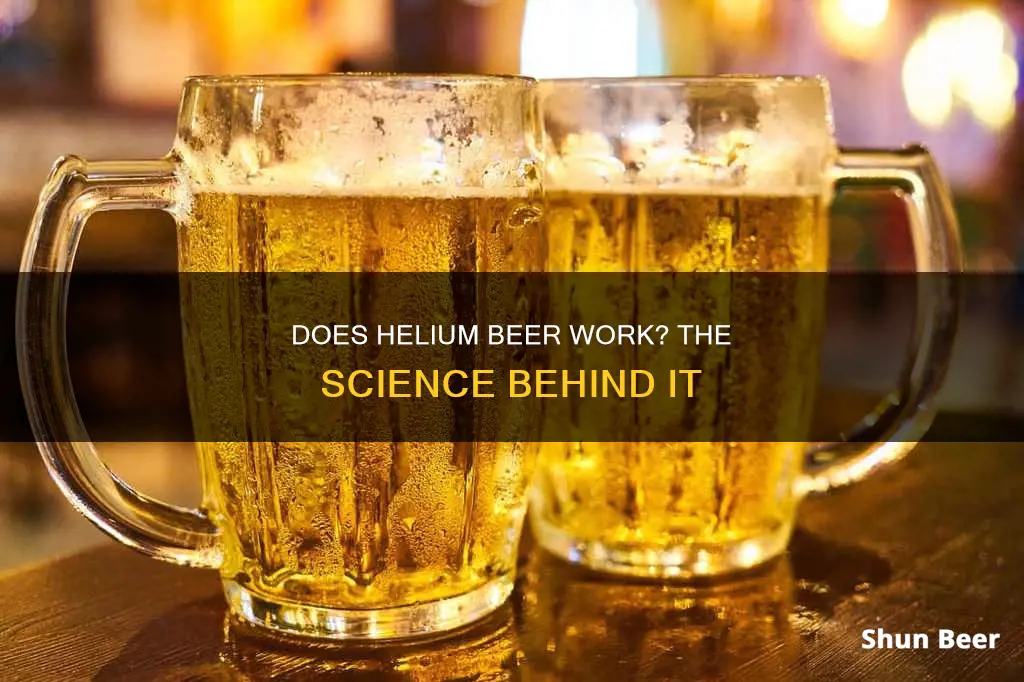
In 2014, two beer companies, Samuel Adams and Stone Brewing, released videos announcing the launch of their helium-infused beers, HeliYum and Cr(He)am Ale, respectively. The videos, which showed drinkers' voices becoming high-pitched after consuming the beer, quickly went viral, sparking curiosity and excitement among beer enthusiasts. However, it later emerged that these videos were April Fool's Day pranks, and the beer never existed. Despite this, the myth of helium beer has persisted, with people continuing to inquire about its availability. While some claim that the laws of science make helium beer impossible, others have suggested methods that could potentially make it a reality.
| Characteristics | Values |
|---|---|
| Possibility of helium beer | Technically possible to infuse helium into beer, but not possible to make helium beer as showcased in popular videos |
| Solubility of helium in water | 700 times less soluble than carbon dioxide |
| Solubility of helium in beer | Insoluble |
| Liquid helium | Turns into gas at -220°F |
| Effect on voice | Does not change the pitch of the drinker's voice |
What You'll Learn

The helium beer hoax
Helium beer is a hoax that originated as an April Fool's prank by the Boston Beer Company's Samuel Adams brand in 2014. The prank involved a video announcing the release of HeliYum, a beer infused with helium that would make drinkers' voices high-pitched. The video was a play on a 1994 hoax email about a hydrogen-infused beer by the fictional Asaka Beer Corporation.
The Samuel Adams video sparked widespread interest and curiosity, with people eager to get their hands on this unique brew. The same day, Stone Brewing released a similar satirical ad for "Stochasticity Project Cr(He)am Ale with Helium," further fuelling the speculation and confusion.
Despite the prank being revealed, the idea of helium beer continued to capture the public's imagination, with numerous copycat videos and articles attempting to debunk the hoax. The fascination with helium beer can be attributed to the desire to experience the unique effects of the beer, such as the high-pitched voice, and the seemingly revolutionary nature of the product.
However, the scientific community has confirmed that creating helium beer is impossible. Helium is not soluble in water or beer, and it turns from liquid to gas at -220°F, which would result in frozen beer. Even if helium were forced into the beer and sealed, it would escape as soon as the seal was broken, creating a mess.
While the hoax may have disappointed many, it showcased the power of creative marketing and the public's willingness to embrace innovative and unconventional ideas. It also served as a reminder to approach viral trends and claims with a critical eye and to consider the underlying science and feasibility.
So, while helium beer may have captured the imagination of beer enthusiasts, it remains firmly in the realm of fantasy and scientific impossibility.
Beer Fast: Does It Work Quickly?
You may want to see also

The science behind helium beer
The idea of helium beer gained popularity after a series of videos were released in 2014, showing people drinking beer and their voices changing in the same way as if they had inhaled helium. However, the concept of helium beer is not scientifically possible due to the insolubility of helium in water and beer. Here is a breakdown of the science behind why helium beer is not possible:
Helium is not soluble in water: Helium is one of the least soluble gases in water, making it difficult to infuse into beer. Compared to carbon dioxide, which is highly soluble and creates the fizz in carbonated beverages, helium is about 700 times less soluble. This means that only a minuscule amount of helium would dissolve in beer, and it would not create the desired fizziness.
Liquid helium has an extremely low boiling point: Liquid helium would be impossible to add to beer because it turns from liquid to gas at -220°F (-140°C). Adding liquid helium to beer would result in a frozen beverage.
Helium is not suitable for carbonation: Carbonation involves infusing a beverage with carbon dioxide or nitrogen gas under pressure. However, since helium is not soluble in beer, it cannot be used for carbonation. Even if helium were forced into the beer and sealed in a can, it would escape as soon as the seal was broken, causing a mess and wasting most of the beer.
Helium would cause gushing: Even if helium could somehow be added to beer, it would result in gushing due to its insolubility. The undissolved helium would form large bubbles and escape from the beer, rather than creating a pleasant fizziness.
While the idea of helium beer captured the imagination of many people, it remains a scientific impossibility due to the unique properties of helium and the way it interacts with water and beer.
Millenials' Work Culture: Beer on the Job?
You may want to see also

The viral videos
The helium beer video is an internet sensation. The original video, posted by Stone Brewing Co. on 1 April 2014, has sparked numerous copycat videos and parodies, with the latest receiving almost 30 million views on Facebook. The videos show people drinking a beer and their voices changing in the same way as if they'd inhaled helium.
The videos have fuelled worldwide demand for helium beer, with people contacting beer companies and publications to ask where they can buy it.
The second (and likely most viral) factor driving the demand for helium beer is a video from Die BierProbierer titled "Helium Beer Test". This video shows two guys allegedly sipping on helium beer with a noticeable change in their voices after drinking the beverage. The "Helium Beer Test" video has been replicated by dozens of viral Facebook video publishers worldwide.
On the same day that Stone Brewing Co. posted its video, the Boston Beer Company's Samuel Adams brand also released a video announcing HeliYum, a "radical, extreme new beer that leverages the wonderful properties of helium".
But is it real?
No, it's not. The videos are all April Fool's Day jokes. As one commentator put it: "Guys — here’s the thing: helium beer isn’t real. It’s a myth. The Lochness Monster and that slimy thing from the Upside Down in Stranger Things are more real. In fact, it’s not even scientifically possible."
Beer Taxes: Effective or Just a Burden?
You may want to see also

The public reaction
However, as the hoax was gradually exposed, the public's enthusiasm turned to disappointment. People felt let down, having been fooled by the elaborate prank. Despite the revelation that helium beer is scientifically impossible, the myth has proven persistent, with new variations of the prank appearing each year and some people still holding out hope that they will one day get to try it.
The prank tapped into a desire for novelty and excitement in the beer market, with some craft beer enthusiasts always on the lookout for the next innovative brew. The combination of beer and helium, with the promise of a high-pitched voice, captured the public's imagination and continues to fascinate even after the hoax has been repeatedly exposed.
The public's reaction to the hoax has also been one of amusement, with some people acknowledging the creativity and humour behind the prank. However, others have expressed frustration at the false hope it generated, especially as the prank has been repeated and revived over the years.
Overall, the public reaction to helium beer has been a rollercoaster of emotions, from initial excitement and curiosity to disappointment and, for some, amusement. The hoax has proven to be a persistent urban legend, with some people still holding out hope for a beer that can change their voices.
Beano and Beer: Does the Enzyme Work?
You may want to see also

The future of helium beer
Helium is not soluble in water, and therefore cannot be used to carbonate beer. Even if it could be added, it would freeze the beer, turning from liquid to gas at -220°F. Even if the scientific hurdles could be overcome, the beer would be flat and likely to gush.
The hoax has been so successful that it has been repeated by other breweries, and even variations of the prank video have been made, but the fact remains that helium beer is not, and never will be, a reality. The laws of science dictate that it is impossible, and so the future of helium beer is non-existent.
While it may be disappointing to those who were taken in by the prank, or those who wish to try it, the future of beer will have to remain helium-free.
Beer Left Outside: Still Refreshing or a Disaster?
You may want to see also
Frequently asked questions
No, it's not real. It started as an April Fool's joke by Samuel Adams and Stone Brewing in 2014.
On April 1, 2014, Samuel Adams' founder, Jim Koch, presented a new type of beer called HeliYUM. In the video, his voice became high-pitched after taking a sip, showing the supposed effect of helium beer. On the same day, Stone Brewing released a similar video about their Cr(He)am Ale, further fuelling the viral myth.
Helium is not soluble in water or beer, so you can't carbonate beer with helium like you would with carbon dioxide or nitrogen. Additionally, liquid helium turns into gas at -220°F, so adding it to beer would result in frozen beer. Even if you forced helium into the beer and sealed it, the gas would escape as soon as you opened the container, causing a mess and wasting most of the beer.
While there is no beer that will give you a high-pitched voice, there are beers that use gases other than carbon dioxide. For example, Guinness uses nitrogen, which has a similar solubility level to helium, to create a smoother mouthfeel.







